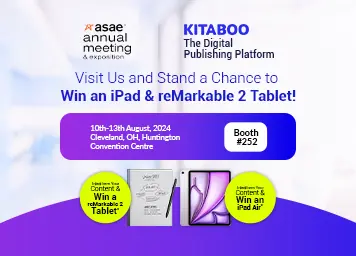
How Can K-12 Publishers Adapt in the Digital Era
Publishers have experienced a digital turbulence in recent times. With certain publishing companies providing a digital rendition of all things that were once available only in print, this has sent the other traditional publishers into a frenzy. Because the digital revolution started eating in to their profits.
The question that now arises is, how can traditional publishers bring back the reader base that they have lost to digitization? Especially a reader base that’s fickle and low on attention span — school students. Students can change their learning preferences in a jiffy, based on what suits their learning needs better.
Well, the answer lies in the question itself- digitization. Just like every other publisher in the business, educational publishers also must take the plunge and dive straight into the midst of digital publishing. K-12 education has traditionally been delivered through textbooks.
K-12 publishers, in their attempt to recover from the losses incurred due to the second-hand book market, used to introduce a new edition every few years. While it was widely known that this move was introduced only to ensure recurring sales, educational institutes supported them by making the newest editions mandatory, and having the students pay a hefty sum for the heavily-priced printed textbooks.
But with the onset of digital publishing, and with major educational publishers like Pearson developing digital textbooks and at the same time earning high profits, other K-12 publishers also had to follow suit to keep their businesses running.
Pearson Adopts a Digital-first Strategy
Textbook publishing giant Pearson recently announced its plans to reduce its textbook publishing. It will now focus on updating its digital products more frequently, offering artificial intelligence capabilities, data analytics and research.
Pearson’s digital-first strategy is a significant step towards a more sustainable business model. Pearson will now offer eBooks at an average cost of $40. Students who prefer actual books can pay $60 for rental, with the option to purchase the book at the end of the term.
The company generates about 62% of its revenue from digital products. And with the planned decrease in printing, it definitely expects to save more by reducing costs for warehousing of large amounts of inventory.
Cengage’s Unlimited Subscription Model
Cengage introduced a subscription model that gives students access to all of the company’s digital course materials for a semester or a year. Students can access more than 20,000 course materials— courseware, eBooks, online homework and study tools, across more than 70 disciplines and 675 courses.
Students get unlimited access to their entire library of online textbooks for $119.99 for four months, $179.99 for one year, and $239.99 for two years. That’s less than half the price of the print textbooks!
Other big publishers like McGraw-Hill and Houghton Mifflin Harcourt have also been investing in digital content for years. This move signals a growing shift in the publishing industry to a “digital-first” model. At present, there’s only one way for K-12 publishers to survive in the digital era, and that is digital publishing.
Let us see how K-12 publishers can further adapt to the digital era.
1. Ditch the traditional printing approach and use an eBook publishing software
Going forward, publishers must make use of new software tools and production processes. With digital publishing, publishers can do away with many of the old time-consuming activities and streamline the production process.
K-12 publishers must first start by investing in an eBook creation software that can help them create highly engaging and immersive course materials. These software packages often include features that can add images, videos, augmented reality, hyperlinks, interactive quizzes and many more enrichments.
The software must also allow publishing of content in multiple formats for various operating systems. With the availability of these tools, K-12 publishers can now finally create and publish eBooks that are far more interesting and interactive than a printed textbook.
2. Use a Training Management System
Going digital also brings in more competition. As every other publisher is keen on developing high quality etextbooks, one has to put in more effort to stay afloat in this business. So now publishers not only have to create eBooks, but also promote and market them to their buyers.
To make things easier, they can use a training management system (TMS). A TMS is a software used to manage the back-office process of training, which involves selling eBooks, maintaining records, administration, getting students to sign up for courseware, managing online sales etc.
3. Focus on the Price Factor
The primary reason why publishers moved to digital-first model was the increasing price of textbooks and the resulting decrease in sales. When students found other alternatives to save their money, such as rental books and second-hand books, publishers decided it was time to provide affordable learning options, without affecting their revenues. Switching to digital was indeed a profitable move for both publishers as well as students.
Publishers can reduce their overall production costs by decreasing the warehouse, transport, printing expenses. And students, finding affordable etextbooks at a reasonable price, can opt to either rent or buy the books. Either way, the price is way less than that of a printed textbook.
Subscription-based model is also one way to go about, where publishers offer etextbooks at less than half the price of a print book, just like Cengage did.
Whitepaper:
The State of Digital Content in Global K-12 Education
4. Offer a Digital Learning Library
Publishers can purchase digital libraries that consist of thousands of video-based learning materials for a much better learning experience. They can have customized K-12 libraries with topics that cover the syllabus of every grade from K to 12.
These learning repositories add value to the publisher’s offerings on the digital market. Educational institutes can utilize these libraries to deliver lessons. And students can have access to thousands of learning resources at once.
5. Publish Superior Content Than OERs
Publishers must be aware of the free learning resources available on the internet – Open Educational Resources (OERs). These materials are available in the public domain and anyone can legally and freely copy and use them.
With free educational resources available, why should students come to you? As mentioned above, there’s already huge competition in the digital publishing market, what with the increasing number of eBook creation software, and the number of K-12 and other publishers going digital.
Hence, you need to produce content that is much more superior and more relevant than what’s being offered by OERs, providing and enriched and engaging learning experience to the students.
Conclusion :
Based on the digital-first strategy adopted by publishing houses like Pearson and MGH, it is evident that going further, digital textbooks and other e-courseware will be an indispensable part of K-12 education.
In order to increase sales, or to keep it steady at the very least, K-12 publishers must deliver exceptional courseware. Competing with sources that offer free and second-hand learning materials at low cost demand an aggressive content and sales planning.
This is because publishers must be able to justify why their products are worth the money. In order to adapt to the digital era, K-12 publishers must look for options where they can develop and publish high-quality etextbooks, while offering them at an affordable price to students.
Contact our expert team now and get started!
To know more, please write to us at KITABOO@hurix.com
Discover how a mobile-first training platform can help your organization.
Kitaboo is a cloud-based platform to create, deliver & track mobile-first interactive training content.





